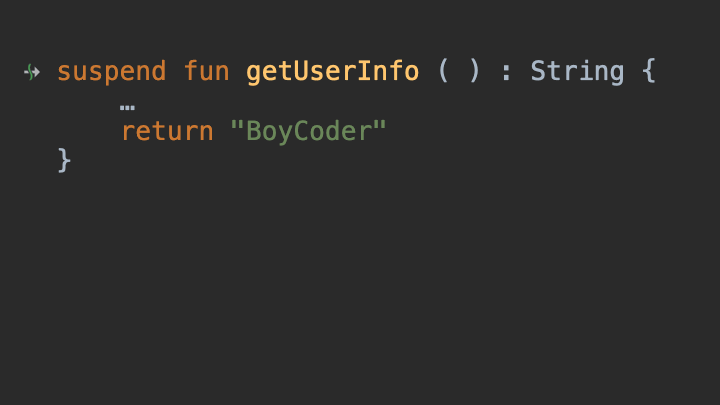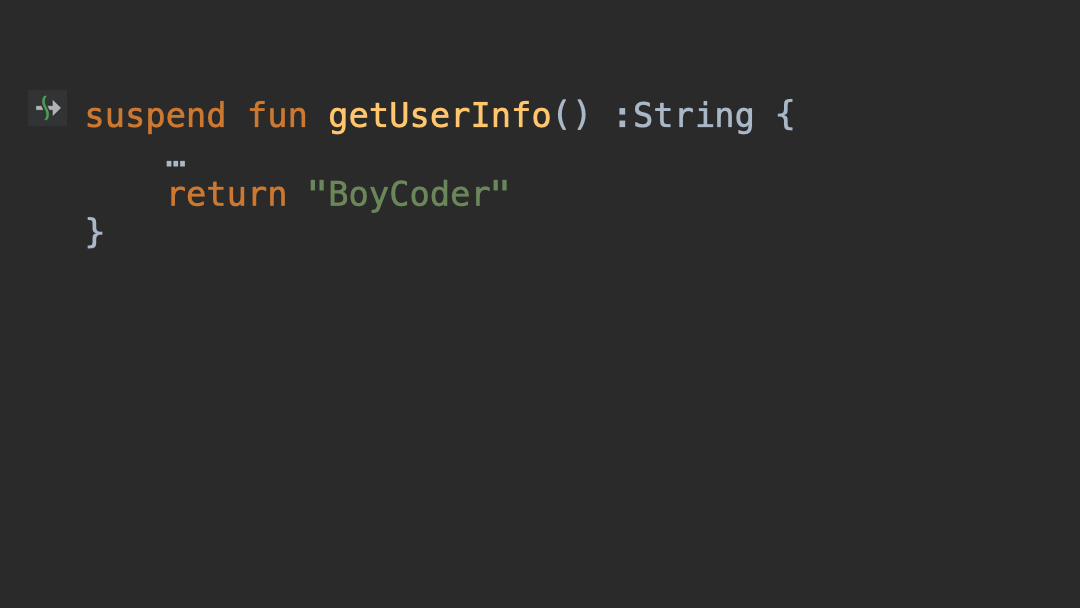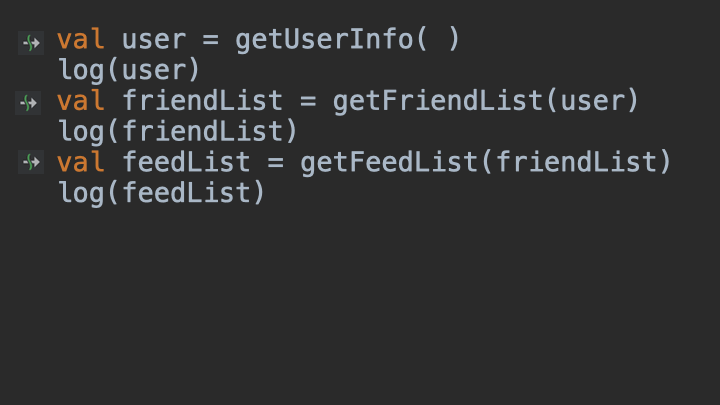27 | 图解挂起函数:原来你就是个状态机?
你好,我是朱涛。今天我们来研究Kotlin挂起函数的实现原理。
挂起函数,是整个Kotlin协程的核心,它的重要性不言而喻。几乎所有协程里的知识点,都离不开挂起函数。而且也正是因为挂起函数的原因,我们才可以使用协程简化异步任务。
今天这节课,我会从这个CPS转换开始说起,带你进一步挖掘它背后的细节。在这个过程中,我们还会接触到Kotlin库当中的协程基础元素:Continuation、CoroutineContext与挂起函数的底层联系。最后,我会带你灵活运用下这些知识点,以此进一步完善我们的KtHttp,让它可以直接支持挂起函数。
好,接下来,我们就正式开始吧!
CPS转换背后的细节
在第15讲当中,我们已经初步介绍过挂起函数的用法了:挂起函数,只是比普通的函数多了suspend关键字。有了这个suspend关键字以后,Kotlin编译器就会特殊对待这个函数,将其转换成一个带有Callback的函数,这里的Callback就是Continuation接口。
而这个过程,我们称之为CPS转换:

以上的CPS 转换过程中,函数的类型发生了变化:suspend ()->String 变成了 (Continuation)-> Any?。这意味着,如果你在Java里访问一个Kotlin挂起函数getUserInfo(),会看到 getUserInfo()的类型是 (Continuation)-> Object,也就是:接收 Continuation 为参数,返回值是Object。
而在这里,函数签名的变化可以分为两个部分:函数参数的变化和函数返回值的变化。
CPS参数变化
我们先来看函数参数的变化,suspend()变成 (Continuation)的情况,这里我们以第15讲当中的代码为例:
// 代码段1suspend fun testCoroutine() {val user = getUserInfo()val friendList = getFriendList(user)val feedList = getFeedList(user, friendList)log(feedList)}//挂起函数// ↓suspend fun getUserInfo(): String {withContext(Dispatchers.IO) {delay(1000L)}return "BoyCoder"}//挂起函数// ↓suspend fun getFriendList(user: String): String {withContext(Dispatchers.IO) {delay(1000L)}return "Tom, Jack"}//挂起函数// ↓suspend fun getFeedList(user: String, list: String): String {withContext(Dispatchers.IO) {delay(1000L)}return "{FeedList..}"}
上面这段代码,testCoroutine()是一个挂起函数,它的内部依次调用了三个挂起函数。而如果我们从Java的角度来看待testCoroutine()的话,代码中所有的参数都会发生变化。如下所示:
// 代码段2// 变化在这里// ↓fun testCoroutine(continuation: Continuation): Any? {// 变化在这里// ↓val user = getUserInfo(continuation)// 变化在这里// ↓val friendList = getFriendList(user, continuation)// 变化在这里// ↓val feedList = getFeedList(friendList, continuation)log(feedList)}
可见,在这里的testCoroutine()当中,每一次函数调用的时候,continuation都会作为最后一个参数传到挂起函数里。不过这一步是Kotlin编译器帮我们做的,我们开发者是无感知的。还记得第15讲我留下的思考题吗:为什么挂起函数可以调用挂起函数,普通函数则不能?
其实,这个问题的答案,我们从代码段2就可以看出来。请想象一下,如果testCoroutine()只是一个普通函数,那它就不会有continuation这个参数了,这样getUserInfo()、getFriendList()、getFeedList()这几个挂起函数自然也就无法被调用了。
CPS返回值变化
好,接下来我们看看getUserInfo()的返回值类型的变化:
// 代码段3suspend fun getUserInfo(): String {}// 变化在这里// ↓fun getUserInfo(cont: Continuation): Any? {}
从上面的代码里,可以看到getUserInfo()的返回值类型从String变成“Any?”。你肯定会好奇,函数原本的String返回值难道丢失了吗?如果原本的返回值类型丢失了,那么程序执行难道不会出问题吗?
其实并不是这样。Kotlin官方之所以要弄这一套CPS转换规则,它必然是“等价转换”。也就是说,String这个原本的返回值类型肯定不会消失,而是会换一种形式存在。只是String存在的形式,经过Kotlin反编译成Java之后会丢失。如果你直接在Java当中调用getUserInfo()的话,就会发现String这个返回值类型成为了Continuation的泛型类型。

所以,对于getUserInfo()这个方法,经过CPS转换后,它完整的函数签名应该是这样的:
// 代码段4suspend fun getUserInfo(): String {}// 变化在这里// ↓fun getUserInfo(cont: Continuation<String>): Any? {}
这时候,我们就可以更新第15讲当中的那个CPS动图了:

好,现在我们知道了,挂起函数原本的返回值类型String只是挪了个地方,所以,Kotlin编译器的CPS转换仍然是等价的转换。也就是:suspend () \-> String 转换成 (Continuation<String>) \-> Any?。不过,这里的“Any?”又是干什么的呢?
其实,挂起函数经过 CPS 转换后,它的返回值有一个重要作用:标志该挂起函数有没有被挂起。这听起来有点绕:挂起函数,就是可以被挂起的函数,它还能不被挂起吗?
是的,挂起函数也能不被挂起。
让我们来理清几个概念。只要有suspend修饰的函数,它就是挂起函数,比如我们前面的例子:
// 代码段5suspend fun getUserInfo(): String {withContext(Dispatchers.IO) {delay(1000L)}return "BoyCoder"}
当getUserInfo()执行到withContext{} 的时候,就会返回 CoroutineSingletons.COROUTINE_SUSPENDED 表示函数被挂起了。
现在问题来了,请问下面这个函数是挂起函数吗?
// 代码段6// suspend 修饰// ↓suspend fun noSuspendFriendList(user: String): String{// 函数体跟普通函数一样return "Tom, Jack"}
这个其实是 noSuspendFriendList()方法,它的方法体跟普通函数一样。它跟一般的挂起函数有个区别:在执行的时候,它并不会被挂起,因为它就是个普通函数。当你写出以下这样的代码后,IDE也会提示你,suspend是多余的:

也就是,当我们调用noSuspendFriendList()这个挂起函数的时候,它不会真正挂起,而是会直接返回String类型:"no suspend"。针对这样的挂起函数,你可以把它看作是伪挂起函数。
所以到这里,挂起函数经过CPS转换后,返回值变成“Any?”的原因也就清晰了:
由于suspend修饰的函数,既可能返回 CoroutineSingletons.COROUTINE_SUSPENDED,也可能返回实际结果 "no suspend",甚至可能返回 null,为了适配所有的可能性,CPS 转换后的函数返回值类型就只能是 Any? 了。
可见我在第15讲当中给出的这个CPS动图,仅仅只是粗略模拟了协程的CPS流程,其中还有很多细节没有体现出来。

那么,为了让你对挂起函数的底层实现原理有一个更加清晰的认识,接下来,我们来看看挂起函数反编译之后会变成什么样。
挂起函数的反编译
我们知道,通过查看Kotlin反编译后的字节码,可以帮助我们理解Kotlin的底层原理。不过,和往常不一样的是,这次我不会直接贴反编译后的代码,因为它的逻辑比较复杂。
所以,为了方便你理解,接下来我贴出的代码是我用Kotlin翻译后大致等价的代码,改善了可读性,抹掉了不必要的细节。当你理解其中的思想后,再去看反编译后的Java代码,会更轻松一些。
好,我们进入正题,这是我们即将研究的对象,testCoroutine()反编译前的代码:
// 代码段7suspend fun testCoroutine() {log("start")val user = getUserInfo()log(user)val friendList = getFriendList(user)log(friendList)val feedList = getFeedList(friendList)log(feedList)}
接下来我们来分析testCoroutine()的函数体,它相当复杂,涉及到三个挂起函数的调用。
首先,在 testCoroutine() 函数里,会多出一个 ContinuationImpl 的子类,它是整个协程挂起函数的核心。
// 代码段8fun testCoroutine(completion: Continuation<Any?>): Any? {// TestContinuation本质上是匿名内部类class TestContinuation(completion: Continuation<Any?>?) : ContinuationImpl(completion) {// 表示协程状态机当前的状态var label: Int = 0// 协程返回结果var result: Any? = null// 用于保存之前协程的计算结果var mUser: Any? = nullvar mFriendList: Any? = null// invokeSuspend 是协程的关键// 它最终会调用 testCoroutine(this) 开启协程状态机// 状态机相关代码就是后面的 when 语句// 协程的本质,可以说就是 CPS + 状态机override fun invokeSuspend(_result: Result<Any?>): Any? {result = _resultlabel = label or Int.Companion.MIN_VALUEreturn testCoroutine(this)}}}
代码中的这个TestContinuation类,是Kotlin编译器帮我们创建的匿名内部类,这里为了方便才用的TestContinuation这个名称。在这个类当中定义了几个成员变量:
- label是用来代表协程状态机当中状态的;
- result是用来存储当前挂起函数执行结果的;
- mUser、mFriendList则是用来存储历史挂起函数执行结果的;
- invokeSuspend这个函数,是整个状态机的入口,它会将执行流程转交给testCoroutine()进行再次调用。
接下来是要判断 testCoroutine 是不是初次运行,如果是初次运行,我们就要创建一个 TestContinuation 的实例对象。
// 代码段9// ↓fun testCoroutine(completion: Continuation<Any?>): Any? {...val continuation = if (completion is TestContinuation) {completion} else {// 作为参数// ↓TestContinuation(completion)}}
也就是:
- invokeSuspend 最终会调用 testCoroutine,然后走到这个判断语句;
- 如果是初次运行,会创建一个 TestContinuation 对象,completion 作为参数;
- 这相当于用一个新的 Continuation 包装了旧的 Continuation;
- 如果不是初次运行,直接将 completion 赋值给 continuation;
- 这说明 continuation 在整个运行期间,只会产生一个实例,这能极大地节省内存开销(对比CallBack)。
接下来是几个变量的定义:
// 代码段10// 三个变量,对应原函数的三个变量lateinit var user: Stringlateinit var friendList: Stringlateinit var feedList: String// result 接收协程的运行结果var result = continuation.result// suspendReturn 接收挂起函数的返回值var suspendReturn: Any? = null// CoroutineSingletons 是个枚举类// COROUTINE_SUSPENDED 代表当前函数被挂起了val sFlag = CoroutineSingletons.COROUTINE_SUSPENDED
上面的代码,分别代表了函数当中的临时变量、挂起函数执行结果,以及是否挂起的标志位。接着,我们来看看协程状态机的核心逻辑:
// 代码段11when (continuation.label) {0 -> {// 检测异常throwOnFailure(result)log("start")// 将 label 置为 1,准备进入下一次状态continuation.label = 1// 执行 getUserInfosuspendReturn = getUserInfo(continuation)// 判断是否挂起if (suspendReturn == sFlag) {return suspendReturn} else {result = suspendReturn//go to next state}}1 -> {throwOnFailure(result)// 获取 user 值user = result as Stringlog(user)// 将协程结果存到 continuation 里continuation.mUser = user// 准备进入下一个状态continuation.label = 2// 执行 getFriendListsuspendReturn = getFriendList(user, continuation)// 判断是否挂起if (suspendReturn == sFlag) {return suspendReturn} else {result = suspendReturn//go to next state}}2 -> {throwOnFailure(result)user = continuation.mUser as String// 获取 friendList 的值friendList = result as Stringlog(friendList)// 将协程结果存到 continuation 里continuation.mUser = usercontinuation.mFriendList = friendList// 准备进入下一个状态continuation.label = 3// 执行 getFeedListsuspendReturn = getFeedList(user, friendList, continuation)// 判断是否挂起if (suspendReturn == sFlag) {return suspendReturn} else {result = suspendReturn//go to next state}}3 -> {throwOnFailure(result)user = continuation.mUser as StringfriendList = continuation.mFriendList as StringfeedList = continuation.result as Stringlog(feedList)loop = false}}
在testCoroutine()这个方法体当中,一共调用了三个挂起函数,这三个挂起函数把整个方法体分割成了4个部分,这四个部分就是上面when表达式当中的4种情况。
- when 表达式实现了协程状态机;
- continuation.label 是状态流转的关键,continuation.label 改变一次,就代表了挂起函数被调用了一次;
- 每次挂起函数执行完后,都会检查是否发生异常;
- testCoroutine 里的原本的代码,被拆分到状态机里各个状态中,分开执行;
- getUserInfo(continuation)、getFriendList(user, continuation)、getFeedList(friendList, continuation) 三个函数调用的是同一个 continuation实例;
- 如果一个函数被挂起了,它的返回值会是
CoroutineSingletons.COROUTINE_SUSPENDED; - 在挂起函数执行的过程中,状态机会把之前的结果以成员变量的方式保存在 continuation中。
上面这一大串文字和代码看着是不是有点晕?你可以再结合着来看看这个视频演示。
那到这里是不是就结束了呢?并不,因为这个动画仅演示了每个协程正常挂起的情况。如果协程并没有真正挂起呢?协程状态机会怎么运行?
协程未挂起的情况
要验证也很简单,我们将其中一个挂起函数改成伪挂起函数即可。
// 代码段12// “伪”挂起函数// 虽然它有 suspend 修饰,但执行的时候并不会真正挂起,因为它函数体里没有其他挂起函数// ↓suspend fun noSuspendFriendList(user: String): String{return "Tom, Jack"}suspend fun testNoSuspend() {log("start")val user = getUserInfo()log(user)// 变化在这里// ↓val friendList = noSuspendFriendList(user)log(friendList)val feedList = getFeedList(friendList)log(feedList)}
testNoSuspend()这样的一个函数体,它反编译后的代码逻辑是怎么样的?
答案其实很简单,它的结构跟前面的testCoroutine()是一致的,只是函数名字变了而已,Kotlin编译器CPS转换的逻辑只认suspend关键字。就算挂起函数内部并没有挂起的逻辑,Kotlin编译器也照样会进行CPS转换。
// 代码段13when (continuation.label) {0 -> {...}1 -> {...// 变化在这里// ↓suspendReturn = noSuspendFriendList(user, continuation)// 判断是否挂起if (suspendReturn == sFlag) {return suspendReturn} else {result = suspendReturn//go to next state}}2 -> {...}3 -> {...}}
那testNoSuspend()的协程状态机是怎么运行的呢?
其实我们也很容易能想到,continuation.label = 0, 2, 3的情况都是不变的,唯独在 label = 1 的时候,suspendReturn == sFlag 这里会有区别。
具体区别我们还是通过动画来看吧:
通过动画我们很清楚地看到了,对于“伪挂起函数”,suspendReturn == sFlag 是会走 else 分支的,在 else 分支里,协程状态机会直接进入下一个状态。
现在只剩最后一个问题了:
// 代码段14if (suspendReturn == sFlag) {} else {// 具体代码是如何实现的?// ↓//go to next state}
答案其实也很简单:如果你去看协程状态机的字节码反编译后的 Java,会看到很多 label。协程状态机底层字节码,是通过 label来实现这个 go to next state 的。由于 Kotlin 没有类似 goto 的语法,下面我用伪代码来表示 go to next state 的逻辑。
// 代码段15// 伪代码// Kotlin 没有这样的语法// ↓ ↓label: whenStartwhen (continuation.label) {0 -> {...}1 -> {...suspendReturn = noSuspendFriendList(user, continuation)if (suspendReturn == sFlag) {return suspendReturn} else {result = suspendReturn// 让程序跳转到 label 标记的地方// 从而再执行一次 when 表达式goto: whenStart}}2 -> {...}3 -> {...}}
需要注意的是:以上只是伪代码,它只是跟协程状态机字节码逻辑上“大致等价”。真实的字节码反编译出来的Java代码,它的可读性要差很多,也更难理解。
// 代码段16// 看不懂也没关系,有个印象即可@Nullablepublic static final Object testCoroutine(@NotNull Continuation $completion) {Object $continuation;label37: {if ($completion instanceof <TestSuspendKt$testCoroutine$1>) {$continuation = (<TestSuspendKt$testCoroutine$1>)$completion;if ((((<TestSuspendKt$testCoroutine$1>)$continuation).label & Integer.MIN_VALUE) != 0) {((<TestSuspendKt$testCoroutine$1>)$continuation).label -= Integer.MIN_VALUE;break label37;}}$continuation = new ContinuationImpl($completion) {// $FF: synthetic fieldObject result;int label;Object L$0;Object L$1;@Nullablepublic final Object invokeSuspend(@NotNull Object $result) {this.result = $result;this.label |= Integer.MIN_VALUE;return TestSuspendKt.testCoroutine(this);}};}Object var10000;label31: {String user;String friendList;Object var6;label30: {Object $result = ((<TestSuspendKt$testCoroutine$1>)$continuation).result;var6 = IntrinsicsKt.getCOROUTINE_SUSPENDED();switch(((<TestSuspendKt$testCoroutine$1>)$continuation).label) {case 0:ResultKt.throwOnFailure($result);log("start");((<TestSuspendKt$testCoroutine$1>)$continuation).label = 1;var10000 = getUserInfo((Continuation)$continuation);if (var10000 == var6) {return var6;}break;case 1:ResultKt.throwOnFailure($result);var10000 = $result;break;case 2:user = (String)((<TestSuspendKt$testCoroutine$1>)$continuation).L$0;ResultKt.throwOnFailure($result);var10000 = $result;break label30;case 3:friendList = (String)((<TestSuspendKt$testCoroutine$1>)$continuation).L$1;user = (String)((<TestSuspendKt$testCoroutine$1>)$continuation).L$0;ResultKt.throwOnFailure($result);var10000 = $result;break label31;default:throw new IllegalStateException("call to 'resume' before 'invoke' with coroutine");}user = (String)var10000;log(user);((<TestSuspendKt$testCoroutine$1>)$continuation).L$0 = user;((<TestSuspendKt$testCoroutine$1>)$continuation).label = 2;var10000 = getFriendList(user, (Continuation)$continuation);if (var10000 == var6) {return var6;}}friendList = (String)var10000;log(friendList);((<TestSuspendKt$testCoroutine$1>)$continuation).L$0 = user;((<TestSuspendKt$testCoroutine$1>)$continuation).L$1 = friendList;((<TestSuspendKt$testCoroutine$1>)$continuation).label = 3;var10000 = getFeedList(friendList, (Continuation)$continuation);if (var10000 == var6) {return var6;}}String feedList = (String)var10000;log(feedList);return Unit.INSTANCE;}
当然,对于上面反编译出来的Java代码,即使你看不懂也没关系,你只需要理解我们前面讲解的逻辑即可。本质上来说,Kotlin协程就是通过 label 代码段嵌套,配合 switch 巧妙构造出一个状态机结构,这种逻辑比较复杂,相对难懂一些。毕竟 Java 的 label 在实际开发中用的很少。
注意:Kotlin挂起函数反编译出来的Java代码,会因为实际开发环境的不同出现细微差异。随着Kotlin编译器的发展,将来可能会对这部分逻辑进一步优化,但它的核心状态机思想是不会轻易改变的。
好,到现在,我们就已经彻底弄懂挂起函数的实现原理了。接下来,我们就结合刚刚学习的内容,来进一步思考实战一下。
思考与实战
在上节课我曾提到过,Kotlin协程的源代码其实分为三层,其中基础层当中的“基础概念”尤为重要。那么,Kotlin官方为我们提供了哪些与挂起函数相关的基础元素呢?
我们首先想到的,肯定就是Continuation.kt,在这里面,确实也可以找到一些跟挂起函数相关的基础元素。
// 代码段17public interface Continuation<in T> {public val context: CoroutineContextpublic fun resumeWith(result: Result<T>)}@Suppress("WRONG_MODIFIER_TARGET")public suspend inline val coroutineContext: CoroutineContextget() {throw NotImplementedError("Implemented as intrinsic")}
在上面的代码中,我们最熟悉的就是Continuation这个接口了,除此之外,还有一个顶层的变量值得我们注意:suspend inline val coroutineContext。要知道,我们从来都是用suspend修饰函数的,从未见过suspend修饰变量的情况。
如果我们依葫芦画瓢,创建一个类似的顶层变量的话,编译器甚至会报错:
// 代码段18// 报错public suspend inline val test: CoroutineContextget() = TODO()
由此可见,suspend的这种用法只是一种特殊用法。结合“public suspend inline val”这几个关键字来看,我们其实可以大致推测出它的作用:它是一个只有在挂起函数作用域下,才能访问的顶层的不可变的变量。这里的inline,意味着它的具体实现会被直接复制到代码的调用处。
17讲思考题解答
为了验证我们前面的猜测,我们可以回过头来看看第17讲的思考题:
// 代码段19import kotlinx.coroutines.*import kotlin.coroutines.coroutineContext// 挂起函数能可以访问协程上下文吗?// ↓suspend fun testContext() = coroutineContext
如果你将上面的代码反编译成Java的话,它就会变成这样:
// 代码段20public static final Object testContext(Continuation $completion) {return $completion.getContext();}
由此可见,代码段17当中的“suspend inline val coroutineContext”,本质上就是Kotlin官方提供的一种方便开发者在挂起函数当中,获取协程上下文的手段。它的具体实现,其实是Kotlin编译器来完成的。
// 代码段19import kotlinx.coroutines.*import kotlin.coroutines.coroutineContext// Continuation当中的coroutineContext// ↓suspend fun testContext() = coroutineContext
到这里,你就会发现一个有趣的现象:我们在挂起函数当中无法直接访问Continuation对象,但可以访问到Continuation当中的coroutineContext。要知道,正常情况下,我们想要访问Continuation.coroutineContext,首先是要拿到Continuation对象的。
但是,Kotlin官方通过“suspend inline val coroutineContext”这个顶层变量,让我们开发者能直接拿到coroutineContext,却对Continuation毫无感知。
所以到这里,我们其实也就可以回答第17节课思考题的问题了。
课程里,我提到了“挂起函数”与 CoroutineContext 也有着紧密的联系,请问,你能找到具体的证据吗?
解答:挂起函数与 CoroutineContext 确实有着紧密的联系。每个挂起函数当中都会有Continuation,而每个Continuation当中都会有coroutineContext。并且,我们在挂起函数当中,就可以直接访问当前的coroutineContext。
KtHttp支持挂起函数
在第18讲当中,我们并没有让KtHttp直接支持挂起函数,当时我们的做法是给KtCall扩展了一个await()方法,从而实现挂起函数调用的。
那么,经过这节课的学习,我们就可以来尝试让KtHttp直接支持挂起函数了,也就是我们可以这样来写代码:
interface ApiServiceV7 {@GET("/repo")// 1,挂起函数suspend fun reposSuspend(@Field("lang") lang: String,@Field("since") since: String): RepoList}private fun <T : Any> invoke(path: String, method: Method, args: Array<Any>): Any? {// 省略return when {isSuspend(method) -> {// 2,支持挂起函数}isKtCallReturn(method) -> {// 省略}isFlowReturn(method) -> {// 省略}else -> {// 省略}}}// 3,判断是不是挂起函数private fun isSuspend(method: Method) = method.kotlinFunction?.isSuspend ?: false// 4,真正执行网络请求的方法suspend fun <T: Any> realCall(call: Call, gson: Gson, type: Type): T = suspendCancellableCoroutine { continuation ->call.enqueue(object : Callback {override fun onFailure(call: Call, e: IOException) {continuation.resumeWithException(e)}override fun onResponse(call: Call, response: okhttp3.Response) {try {val t = gson.fromJson<T>(response.body?.string(), type)continuation.resume(t)} catch (e: Exception) {continuation.resumeWithException(e)}}})continuation.invokeOnCancellation {call.cancel()}}
这段代码一共有4个注释,我们一个个看:
- 注释1,这其实就是我们希望达到的效果,可以在ApiServiceV接口当中直接定义挂起函数。
- 注释2,在KtHttp 6.0版本的基础上,我们在invoke()的when表达式里增加了一个分支:isSuspend()。
- 注释3,isSuspend()的实现有一个细节,这里我们使用了“method.kotlinFunction”,将Java的method转换成了kotlinFunction,这样一来,它就变成了一个Kotlin反射的对象了。因此,我们就可以查询到一些Kotlin相关的信息,比如说,它是不是一个挂起函数。
- 注释4,为了直接在挂起函数里执行网络请求,我们将KtCall当中的部分代码逻辑挪了进来。这个realCall()方法,它被定义成了一个挂起函数。
基于以上的分析,我们其实只需要借助反射,完成注释2处的代码逻辑,然后调用realCall()这个挂起函数就行了。
private fun <T : Any> invoke(path: String, method: Method, args: Array<Any>): Any? {// 省略return when {isSuspend(method) -> {// 1,反射获取类型信息// 2,调用realCall()}isKtCallReturn(method) -> {// 省略}isFlowReturn(method) -> {// 省略}else -> {// 省略}}}
所以,接下来我们要做的事情大致可以分为两个部分。
第一个部分,获取类型信息,准备请求网络,这个部分其实很简单。但在第二个部分“支持挂起函数”这里会遇到问题:
private fun <T : Any> invoke(path: String, method: Method, args: Array<Any>): Any? {// 省略return when {isSuspend(method) -> {// 支持挂起函数val genericReturnType = method.kotlinFunction?.returnType?.javaType ?: throw IllegalStateException()val call = okHttpClient!!.newCall(request)// 报错!!realCall<T>()}isKtCallReturn(method) -> {// 省略}isFlowReturn(method) -> {// 省略}else -> {// 省略}}}
以上代码报错的原因也很容易理解,realCall()是一个挂起函数,它无法在普通函数里被调用!所以这里我们就面临了一个问题:如何在普通Kotlin函数当中调用挂起函数?
那么,我们首先可以想到的解决办法,就是强制类型转换:
private fun <T : Any> invoke(path: String, method: Method, args: Array<Any>): Any? {// 省略return when {isSuspend(method) -> {// 支持挂起函数val genericReturnType = method.kotlinFunction?.returnType?.javaType ?: throw IllegalStateException()val call = okHttpClient!!.newCall(request)val continuation = args.last() as? Continuation<T>// 1,将挂起函数类型转换成,带Continuation的类型,报错val func = ::realCall as (Call, Gson, Type, Continuation<T>?) -> Any?func.invoke(call, gson, genericReturnType, continuation)}isKtCallReturn(method) -> {// 省略}isFlowReturn(method) -> {// 省略}else -> {// 省略}}}
请留意代码中的注释1,我们尝试使用“函数引用”的方式,将realCall()转换成了带有Continuation的函数类型,这样我们就可以通过传入Continuation,来调用realCall()这个挂起函数了。
不过,事与愿违,我们的方法并不能奏效,因为这行代码会报错,原因是realCall()带有泛型,而Kotlin暂时不支持“函数引用带泛型”的语法。
所以在这里,为了让这个Demo能运行起来,我们可以定义一个临时方法:
private fun <T : Any> invoke(path: String, method: Method, args: Array<Any>): Any? {// 省略return when {isSuspend(method) -> {// 支持挂起函数val genericReturnType = method.kotlinFunction?.returnType?.javaType ?: throw IllegalStateException()val call = okHttpClient!!.newCall(request)val continuation = args.last() as? Continuation<T>// 1,使用临时方法消除泛型val func = ::temp as (Call, Gson, Type, Continuation<T>?) -> Any?func.invoke(call, gson, genericReturnType, continuation)}isKtCallReturn(method) -> {// 省略}isFlowReturn(method) -> {// 省略}else -> {// 省略}}}suspend fun temp(call: Call, gson: Gson, type: Type) = realCall<RepoList>(call, gson, type)
在上面的代码中,我们使用了一个临时方法消除了泛型T,写死了返回值类型RepoList。这样的代码,在Demo当中是可以运行的,这从侧面也能印证我们上面代码中的类型转换是成功的。
fun main() = runBlocking {val data: RepoList = KtHttpV7.create(ApiServiceV7::class.java).reposSuspend(lang = "Kotlin",since = "weekly")println(data)}/*输出结果正常*/
不过,这种做法明显不具备普适性,为了让KtHttp支持所有类型的API请求,我们必须要想其他的办法。具体来说,我们可以这样做:
private fun <T : Any> invoke(path: String, method: Method, args: Array<Any>): Any? {// 省略return when {isSuspend(method) -> {// 支持挂起函数val genericReturnType = method.kotlinFunction?.returnType?.javaType ?: throw IllegalStateException()val call = okHttpClient!!.newCall(request)val continuation = args.last() as? Continuation<T>val func = KtHttpV7::class.getGenericFunction("realCall")// 反射调用realCall()func.call(this, call, gson, genericReturnType, continuation)}isKtCallReturn(method) -> {// 省略}isFlowReturn(method) -> {// 省略}else -> {// 省略}}}// 2,获取方法的反射对象fun KClass<*>.getGenericFunction(name: String): KFunction<*> {return members.single { it.name == name } as KFunction<*>}
其实,这种思路跟前面的思路是类似的,我们仍然是对realCall()的类型进行了转换,只不过是通过反射来实现的而已。所以最重要的,我们还是要弄清楚Kotlin挂起函数CPS转换的细节。
小结
这节课,我们通过研究挂起函数的反编译代码,发现了Kotlin的挂起函数,本质上就是一个状态机。其中主要涉及到下面几个知识点,我们需要重点掌握好。
- Kotlin挂起函数的CPS转换,它的函数签名变化主要分为两个部分,第一部分是参数的变化,挂起函数经过Kotlin编译器转换以后,它会多出一个Continuation类型的参数。第二部分是返回值类型的变化,挂起函数原本的返回值类型,会被挪到Continuation当中作为泛型参数,比如
Continuation<String>,而转换过后的函数返回值类型会变成“Any?”类型。 - 当挂起函数经过反编译以后,它会变成由switch和label组成的状态机结构。
- 为了便于研究,课程里提供了大致等价的协程状态机代码:其中,when 表达式实现了协程状态机,而continuation.label 则代表了当前状态机的具体状态,continuation.label 改变一次,就代表了挂起函数被调用了一次;
- 在一个挂起函数被调用的时候,它的返回值可能是具体的结果,也可能会是
CoroutineSingletons.COROUTINE_SUSPENDED,这时候就代表了这个函数被挂起了。
另外在这节课里,我们还进行了一次反思和实战,通过研究协程基础层当中的“suspend inline val coroutineContext”这个顶层变量,我们发现了挂起函数与协程上下文之间的紧密联系。并且,我们还灵活运用了这节课学到的知识,进一步改进了KtHttp,让它可以直接支持挂起函数。
你在自己的工作场景当中,其实也可以通过这样思考与实战的方式,来进一步强化所学和所得,甚至可以把输入转化成输出,把知识真正沉淀成你自己的东西。
思考题
我们都知道挂起函数是Kotlin协程里才有的概念,请问,Java代码中可以调用Kotlin的挂起函数吗?比如,下面这个函数,我们可以在Java当中调用吗?
object SuspendFromJavaExample {// 在Java当中如何调用这个方法?suspend fun getUserInfo(id: Long):String {delay(1000L)return "Kotlin"}}